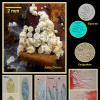
15-01-2026 15:55
 Lothar Krieglsteiner
Lothar Krieglsteiner
this one is especially interesting for me because

17-01-2026 19:35
Arnold BüschlenHallo, ich suche zu Cosmospora aurantiicola Lite

16-01-2026 00:45
Ethan CrensonHi all, On decorticated hardwood from a New York

18-01-2026 12:24
Hello.An anamorph located on the surface of a thin

08-12-2025 17:37
 Lothar Krieglsteiner
Lothar Krieglsteiner
20.6.25, on branch of Abies infected and thickened

10-01-2026 20:00
Tom SchrierHi all,We found picnidia on Protoparmeliopsis mur
Capitotricha ou Lachnum bicolor ?
Roland Labbé,
14-11-2008 01:46
Voici les détails :
Date de récolte : 2008.11.10
Habitat: terrain vague, tas de branches
Hôte: bois mort, écorce de sorbier
Asques nombreuses, , à 8 spores unisériées, avec appareil apical amyloïde, 40-50 x 6-7 um
Spores cylindro-fusoïdes, à paroi mince, non septées, hyalines, 9-12 x 1,5-2 µm, 10,6 x 1,8 µm en moyenne (10 spores), Q = 5,89
Paraphyses rares, cylindriques-filiformes, non septées, non ou rarement guttulées vers l'apex, ré-fringentes, 35-40 x 0,5-1 µm, de longueur égale ou légèrement plus courte que les asques
Poils de l'excipulum fusoïdes, élargis à la base, lancéolés à l’apex, à paroi légèrement épaisse, multi-septés (6-7 septa), irrégulièrement finement incrustés, 80-140 x 2-4 µm
Excipulum en textura globulosa formé de cellules mesurant jusqu'à 10-11 µm de diam.
La photo suivra bientôt.
Roland
Hans-Otto Baral,
14-11-2008 13:12

Re:Capitotricha ou Lachnum bicolor ?
Sounds strange because of the non-.lanecolate paraphyses
Roland Labbé,
14-11-2008 17:30
Re:Capitotricha ou Lachnum bicolor ?
Wright Zotto. That's what I think.
The paraphyses have only 0,5-1 µm wide, but all others characters agree with L. bicolor.
Is it a species of another genus ?
Thank for your contribution again.
Roland
The paraphyses have only 0,5-1 µm wide, but all others characters agree with L. bicolor.
Is it a species of another genus ?
Thank for your contribution again.
Roland
Stip Helleman,
14-11-2008 17:48

Re:Capitotricha ou Lachnum bicolor ?
Cher Roland et Jaqueline'
I think it is better for identification you put a link to the larger image in your sujet, this pictures are still to small to see details.
I searched the web and found it,to my opinion you have a Arachnopeziza here on the Cambium layer of bark (Sorbus is good possible)
http://www.flickr.com/photos/19369983@N06/3026828766/sizes/l/
best wishes Stip
I think it is better for identification you put a link to the larger image in your sujet, this pictures are still to small to see details.
I searched the web and found it,to my opinion you have a Arachnopeziza here on the Cambium layer of bark (Sorbus is good possible)
http://www.flickr.com/photos/19369983@N06/3026828766/sizes/l/
best wishes Stip
Hans-Otto Baral,
14-11-2008 19:01

Re:Capitotricha ou Lachnum bicolor ?
Yes, Stip, seems to be Arachnoscypha aranea.
Zotto
Zotto
Roland Labbé,
14-11-2008 19:32
Re:Capitotricha ou Lachnum bicolor ?
Mais selon la clé de Fuckel emend. Korf. :
Apothécie urceolée à turbinée. Sur involucres de châtaigne (Castanea) pour A. aranea.
Ce qui ne semble pas être le cas ici, ni la forme ?, ni le substrat sur écorce de sorbier.
Roland
Apothécie urceolée à turbinée. Sur involucres de châtaigne (Castanea) pour A. aranea.
Ce qui ne semble pas être le cas ici, ni la forme ?, ni le substrat sur écorce de sorbier.
Roland
Hans-Otto Baral,
14-11-2008 19:47

Re:Capitotricha ou Lachnum bicolor ?
yes, Roland, you are right, it would perhaps be the first time, I also have only finds on cupules and leaves. But I have no other idea. Anybody else?
Zotto
Zotto
Stip Helleman,
14-11-2008 20:24

Re:Capitotricha ou Lachnum bicolor ?
Hello Roland,
The description sais "drying urceolate to turbunate", here apothecia are fresh. But the substrate is strange, perhaps A. eriobasis is a reasonable alternative.
Stip
The description sais "drying urceolate to turbunate", here apothecia are fresh. But the substrate is strange, perhaps A. eriobasis is a reasonable alternative.
Stip
Stip Helleman,
14-11-2008 20:28
Roland Labbé,
14-11-2008 20:49
Re:Capitotricha ou Lachnum bicolor ?
Is Capitotricha a good genus ? Does Lachnum englobe Capitotricha ?
Roland
Roland
Stip Helleman,
14-11-2008 22:22

Re:Capitotricha ou Lachnum bicolor ?
Hello Roland,
Capitotricha is a good genus, and is recognized by a gelatinized excipulum and irragular roughened hairs with crystals, paraphyses contain often conspicious carotene guttules responsible for the orange-yellow color of the hymenium.
Lachnum in its wider sense was used for replacement of the generic name Dasyscyphus and was too heterogenus to remain so quite a numbre of genera are recognized now
Lachnum in its narrow sense contains white-colored species with non gelatinized excipulum and totally granulate hairs with or without crystals. in a number of species the hymeniumcolor is changing in color from yellowish to brick-red on dieing due to thhe presence of refractive vacuolebodies in the paraphyses.
Stip
Capitotricha is a good genus, and is recognized by a gelatinized excipulum and irragular roughened hairs with crystals, paraphyses contain often conspicious carotene guttules responsible for the orange-yellow color of the hymenium.
Lachnum in its wider sense was used for replacement of the generic name Dasyscyphus and was too heterogenus to remain so quite a numbre of genera are recognized now
Lachnum in its narrow sense contains white-colored species with non gelatinized excipulum and totally granulate hairs with or without crystals. in a number of species the hymeniumcolor is changing in color from yellowish to brick-red on dieing due to thhe presence of refractive vacuolebodies in the paraphyses.
Stip
Hans-Otto Baral,
14-11-2008 23:13

Re:Capitotricha ou Lachnum bicolor ?
yes Stip, and Capitotricha is obviously more closely related to the conifericolous genus Lachnellula, so the limits to that genus are sometimes less clear than to Lachnum.
Zotto
Zotto




